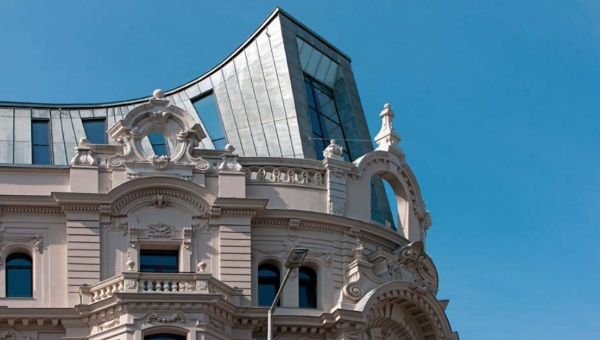Permeations in Space and Time
Eiffel Palace, Budapest
Architects: András Gelesz, Ágnes G. Lenzsér, Eszter Holló, Gergely Schöff, Kornél Baliga
Text: Edit Pálinkás
Photos: Tamás Bujnovszky

Eiffel Palace is an exceptional example of the investor’s attitude prioritizing the preservation of the city’s values besides the interests of clients. The reconstruction of the building has been realized as a project reflecting this, Thus a prestigious office block was created which is also sensitive to architectural values and thus inspires similar ones. The building was built between 1893 and 1894 to house the editorial offices of Pesti Hírlap, a daily paper then, and its printing press, as well as apartments to rent. World War II caused serious damage to both the facades and the cupolas of the attic – including their complex structures. These were partly restored but they failed to rebuild the cupolas and the ornaments. Since 1996 it has stood unoccupied. During the conversion stage the glass roof was elevated above the fifth storey to expose the richly decorated cast-iron frame of the former wrap-around internal gallery. The interior facades facing the courtyard are actually homogeneous frameless glass partitions behind the facelifted wrought-iron structures: they are receded to evoke the system of external wrap-around galleries of the former building. The cast-iron structure is supported by V struts on the ground floor with bases of various size whilst on the shorter side by steel pillars of slanting planes. The roofed-in courtyard is a public area which can be freely used by anyone – which makes it an important factor of both the everyday life of the building and that of the the city. By preserving the facades and restoring them to their original beauty, the building was made to be able to keep the architectural traditions of Budapest alive and perfectly integrate into the cityscape which dates back to several centuries.
Client: Eiffel Palace Kft.
Investor: HORIZON
General design: DVM Design Kft.
Architecture: Gelesz és Lenzsér Kft
Leading architect: András Gelesz
Architcets: Ágnes G. Lenzsér, Eszter Holló, Gergely Schöff
Fellow architects: Péter Safranka, Mária Horváth
Insulation, metal roof: Sándor Horváth, Csaba Czégeni – Pataky és Horváth Építésziroda Kft.
Glasswork: Márton Kucsera Cutting Edge Face Mérnök Iroda Kft.
Elevation: Kornél Baliga – Korinterni Bt.
Art historian: Ferenc Dávid
Interior design: Éva Joó, Tamás Kovács – DVM Design Kft.
Design concept: Nóra Demeter, Róbert Tóth – Zoboki-Demeter és Társaik Építésziroda Kft.
Structure: János Volkai – TM Janeda Kft.
HVAC: Zoltán Sor, József Kiss – PHQ Kft.
Electrical engineering: Attila Pál – VECO Kft.
Traffic: Ádám Rhorer – Közlekedés Kft.
Garden elements: Brigitta Nádai
Main constructor: DVM Construction Kft.








